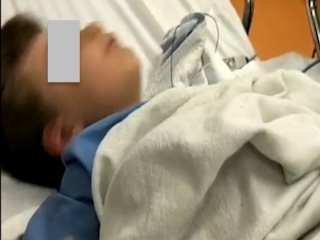Epileptic Disorders
MENUThe epilepsy-movement disorder phenotypic spectrum and phenytoin-induced dyskinesia associated with GABRB3 pathogenic variants Volume 23, numéro 6, December 2021
Gamma-aminobutyric acid (GABA) A receptors are ligand-gated chloride channels responsible for maintaining inhibitory tone in the brain. Heterozygous pathogenic variants in GABRB3, encoding the β3 subunit of the GABAA receptor, have been implicated in several epilepsy syndromes [1]. Since GABAA receptors are critical for excitability regulation, deleterious loss-of-function pathogenic variants can result in GABAergic disinhibition, promote hyperexcitability, and lead to several genetic epilepsies [2]. Recently, the overlap between epilepsy syndromes and movement disorders has been widely recognized and numerous genes, including those that encode GABAA receptor subunits, such as GABRB3, GABRA2, GABRG2, and GABRB2, have been associated with both phenotypes [3]. We report a seven-year-old male patient, known for epilepsy due to a de novo pathogenic GABRB3 variant, who developed dyskinesia after receiving a phenytoin load. Our case provides further support that GABRB3 dysfunction can be associated with movement disorders and suggests that a genetic predisposition may underlie phenytoin-induced dyskinesia.
Our patient is a seven-year-old male known for epilepsy, global developmental delay, mild to moderate intellectual disability and autism spectrum disorder secondary to a pathogenic de novo GABRB3 variant (NM_021912.4: c.413_415dupACC; p.Asn138_Arg139insHis). He had an uncomplicated pregnancy and an induced vaginal delivery at 41 weeks. He was diagnosed with epileptic spasms at two months of age and was treated with vigabatrin and ACTH unsuccessfully. He developed other seizure types including eye convergence and nystagmus, head deviation, atonic head nods, and myoclonic jerks. EEG evolved into burst suppression. At the age of four months, topiramate was introduced with moderate effect and optimal seizure control was finally achieved with levetiracetam. Vigabatrin and levetiracetam were weaned successfully at nine months and 4.5 years of age, respectively.
At the age of seven years, during an attempted weaning of topiramate, the patient presented with brief bilateral tonic-clonic seizures appearing mostly during sleep. Reintroduction of topiramate did not resolve the seizures and the patient was hospitalized for status epilepticus requiring the use of IV phenytoin. Shortly after the phenytoin load, he developed dyskinesia of his face, arm and leg that lasted 24-48 hours (see video sequence). The self-resolved dyskinesias were attributed to phenytoin toxicity with documentation of a phenytoin total blood level of 118 μmol/L (normal range: 40-80 μmol/L).
Pathogenic variants in genes encoding different GABA receptor subunits, such as GABRG2, GABRA1, GABRD, GABRB2, and GABRB3, have been associated with a broad phenotypic spectrum of epilepsies [1]. GABRB3 pathogenic variants cause multiple epileptic syndromes such as genetic epilepsy with febrile seizures plus, myoclonic astatic epilepsy, West syndrome, Dravet Syndrome, Lennox-Gastaut syndrome, epilepsy of infancy with migrating focal seizures and early infantile epileptic encephalopathy as well as developmental encephalopathy, intellectual disability and autism [1, 3–6]. GABRB3 pathogenic variants alter GABAA channel gating by decreasing the probability of channel opening or by altering channel deactivation, leading to decreased GABA inhibition [1]. Furthermore, GABRB3 pathogenic variants result in the impaired presence and clustering of GABAA receptors at synapses, especially inhibitory synapses [7].
Epilepsy-movement disorder phenotypes have been recently recognized in individuals with pathogenic variants of genes encoding GABA receptor subunits. Patients with de novo GABRA2 or GABRG2 pathogenic variants have been described presenting with early-onset epilepsy and varying movement disorders such as choreoathetosis, hand stereotypies, and hand posturing [3]. A handful of reports have described movement disorders in patients with GABRB3 pathogenic variants, which are summarized in table 1, and include dystonia, dyskinesia and ataxia [1, 4].
Phenytoin-induced dyskinesia can occur at any time during the course of therapy and even at non-toxic concentrations. However, this side effect occurs more often with polytherapy and with toxic levels, which was the case in our patient [8]. Also, phenytoin-induced dyskinesia is frequently reported in children with epileptic encephalopathy and patients with pre-existing dyskinesias, suggesting the possible presence of underlying genetic susceptibility [8-10]. We theorise that the cause of the dyskinesia in our patient was multifactorial, including polypharmacy, increased phenytoin serum concentration and predisposition to movement disorders due to a GABRB3 pathogenic variant.
In summary, this report provides further evidence suggesting that GARBR3 is implicated in an epilepsy-movement disorder phenotypic spectrum, and suggests that genetic factors, such as GABRB3 pathogenic variants, may represent a susceptibility to phenytoin-induced dyskinesia.
Supplementary material
Summary slides accompanying the manuscript are available at www.epilepticdisorders.com.
Acknowledgements and disclosures
The authors thank the patient and the parents for their contribution to this study.
The authors report no disclosures relevant to the manuscript.


